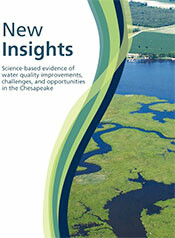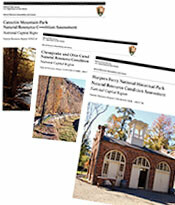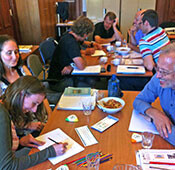Cloud Solutions Specialist for the Chesapeake Collaborative Computer Center
The University of Maryland Center for Environmental Science invites applications for a Cloud Solutions Specialist. This position is a great opportunity to use your skills and experience to contribute to a variety of highly visible projects while learning about the latest technologies and best practices. The successful candidate will work in partnership with the U.S. EPA Chesapeake Bay Program staff at its Annapolis office.New Insights: Science-based evidence of water quality improvements, challenges, and opportunities in the Chesapeake
 Over the past several decades, scientists, natural resource managers, and the general public have become increasingly concerned about the impaired health of the Chesapeake Bay. The degradation of water quality and habitat conditions throughout the Bay led to the development of the Chesapeake Bay Total Maximum Daily Loads (TMDL) for nitrogen, phosphorus, and sediment. The watershed implementation plan has reinforced the need to understand the effectiveness of best management practices (BMPs) to ensure compliance with local and regional water quality load allocations and targets. This report summarizes the results from more than 40 case studies of water quality monitoring in the Chesapeake Bay watershed.
Over the past several decades, scientists, natural resource managers, and the general public have become increasingly concerned about the impaired health of the Chesapeake Bay. The degradation of water quality and habitat conditions throughout the Bay led to the development of the Chesapeake Bay Total Maximum Daily Loads (TMDL) for nitrogen, phosphorus, and sediment. The watershed implementation plan has reinforced the need to understand the effectiveness of best management practices (BMPs) to ensure compliance with local and regional water quality load allocations and targets. This report summarizes the results from more than 40 case studies of water quality monitoring in the Chesapeake Bay watershed.
Natural resource condition assessments for Harpers Ferry National Historical Park, Catoctin Mountain Park, and Chesapeake and Ohio Canal National Historical Park
 IAN worked with the National Park Service to develop natural resource condition assessments for Harpers Ferry National Historical Park, Catoctin Mountain Park, and Chesapeake and Ohio Canal National Historical Park. The natural resources of all three parks were predicted to be negatively affected by climate change. Impacts may include increasing ozone levels and particle pollution, raising the water temperature of these cold-water, trout-supporting streams, changing forest composition, and affecting exotic species and forest pests and diseases. Additionally, all three parks were identified as being under threat from surrounding land use, regionally poor air quality, and overpopulation of deer.
IAN worked with the National Park Service to develop natural resource condition assessments for Harpers Ferry National Historical Park, Catoctin Mountain Park, and Chesapeake and Ohio Canal National Historical Park. The natural resources of all three parks were predicted to be negatively affected by climate change. Impacts may include increasing ozone levels and particle pollution, raising the water temperature of these cold-water, trout-supporting streams, changing forest composition, and affecting exotic species and forest pests and diseases. Additionally, all three parks were identified as being under threat from surrounding land use, regionally poor air quality, and overpopulation of deer.
IAN is back in Australia
 In early February, Bill Dennison, Alex Fries, and Heath Kelsey traveled to Australia for a series of project workshops. Bill and Heath were in Townsville for the second Great Barrier Reef Climate Change Resilience Index workshop. IAN was tasked with facilitating a workshop to coordinate a team of investigators to develop a climate change resilience index from a series of indicators. Alex then joined Heath in Adelaide for a science communication course focusing on Report Cards. The course was designed as a series of intermediate level modules for the South Australia Government who have been preparing various regional environmental report cards. Finally, Heath and Alex continued to Gladstone to facilitate a meeting to develop the first Gladstone Harbour Report Card. All meetings went well, and provided great opportunities for ongoing interaction on a variety of issues.
In early February, Bill Dennison, Alex Fries, and Heath Kelsey traveled to Australia for a series of project workshops. Bill and Heath were in Townsville for the second Great Barrier Reef Climate Change Resilience Index workshop. IAN was tasked with facilitating a workshop to coordinate a team of investigators to develop a climate change resilience index from a series of indicators. Alex then joined Heath in Adelaide for a science communication course focusing on Report Cards. The course was designed as a series of intermediate level modules for the South Australia Government who have been preparing various regional environmental report cards. Finally, Heath and Alex continued to Gladstone to facilitate a meeting to develop the first Gladstone Harbour Report Card. All meetings went well, and provided great opportunities for ongoing interaction on a variety of issues.
IAN welcomes Kiri Carini
 Kiri Carini recently joined IAN and will be assisting us with our many Geographic Information System (GIS) needs. Kiri is a native Oregonian and received a Bachelor of Science from the University of Southern California Price School of Public Policy. Prior to moving to Maryland, Kiri managed the Seismic Retrofit Grant Program for the State of Oregon Office of Emergency Management. Kiri has 7 years of experience using GIS for land use development, including long range planning, site suitability analysis, and environmental impact reports. Kiri is embracing life as a flat-lander on the Eastern Shore where she aspires to become a kayaking photographer of birds.
Kiri Carini recently joined IAN and will be assisting us with our many Geographic Information System (GIS) needs. Kiri is a native Oregonian and received a Bachelor of Science from the University of Southern California Price School of Public Policy. Prior to moving to Maryland, Kiri managed the Seismic Retrofit Grant Program for the State of Oregon Office of Emergency Management. Kiri has 7 years of experience using GIS for land use development, including long range planning, site suitability analysis, and environmental impact reports. Kiri is embracing life as a flat-lander on the Eastern Shore where she aspires to become a kayaking photographer of birds.